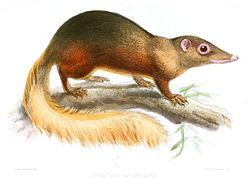| Edworthia Temporal range: Early Paleocene | |
|---|---|
| Scientific classification | |
| Kingdom: | Animalia |
| Phylum: | Chordata |
| Class: | Mammalia |
| Order: | † Plesiadapiformes |
| Family: | † Paromomyidae |
| Genus: | † Edworthia Fox, Scott & Rankin, 2010 |
| Species | |
| |
Edworthia is an extinct genus of paromomyid plesiadapiform which existed in Alberta, Canada, during the early Paleocene (middle Torrejonian age). [1] It was first named by Richard C. Fox, Craig S. Scott and Brian D. Rankin in 2010 and the type species is Edworthia lerbekmoi. [1] Edworthia was described from a recently discovered locality in the Paskapoo Formation, exposed at a road cut in Edworthy Municipal Park. [1]




